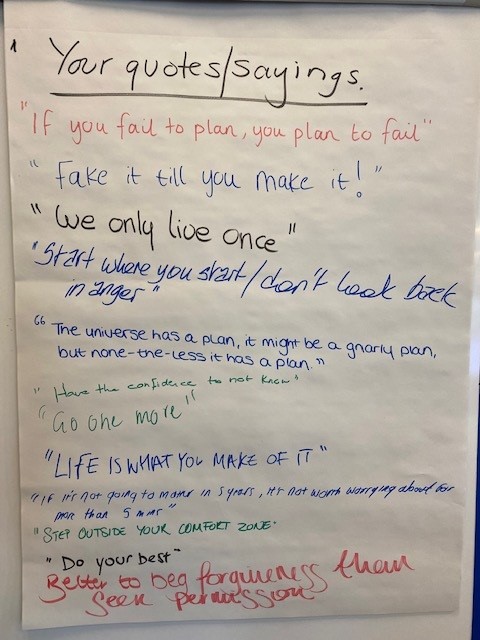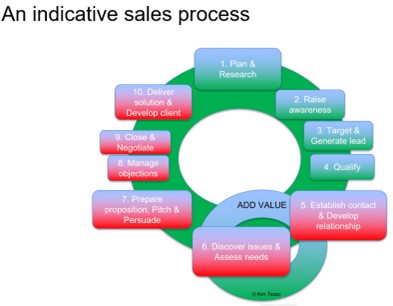
Early in December we enjoyed an interactive and productive day at Taylor Wessing (Thank you for hosting!) for a day workshop on “Future Marketing/BD Manager” with PM Forum. This post was prepared for the delegates as a reminder of the key themes and an additional learning resource. Future Marketing/BD Manager – Build your personal brand and increase your strategic contribution.
Build your personal brand – Perception and Visibility
We started the day with delegates reflecting on their favourite quotes and sayings – as a way to uncover their underlying key values which will form the basis of their personal brand (These are shown in the image above).
We discussed various models to support the development of your personal brand e.g.
- PIA (Presence, Impact and Authority) How do you make a personal impact – Make a difference (kimtasso.com)
- PVI (Perception, Visibility, Influence) ( Be more visible – the PVI model (kimtasso.com)
- PIE (Harvey Colman – Performance (10%), Image (30%) and Exposure (60%))
There’s also some helpful advice here: Increasing Your Visibility – Raising Your Profile at Work (mindtools.com)
Personal brands featured strongly in both the initial delegate aims for the day and also when we considered our key takeaways at the end of session.
Delegate aims
At the start of the day, delegates shared their learning aims:
- Personal brand
- Develop both hard (technical) and soft (interpersonal) skills
- Network with peers
- Increase confidence
- Be more persuasive
- Overcome limiting assumptions Before your set your goals – check your limiting assumptions (kimtasso.com)
- Overcome my “imposter syndrome”
- Prepare to be a manager (next year)
- Management capabilities
- Learn how to manage others
- Get the best out of people
- Support new members of the team
- Balance support and direction
- Manage boundaries as moving from “part of the team” to “managing the team”
- Learn how to work more effectively with “difficult” behaviours
- Learn how other M&BD teams operate
- Be more strategic
Increase your strategic contribution
Two themes emerged at the end of the day in the takeaways – manage your personal brand and increase your strategic contribution:
- Manage my personal brand
- Define my values and develop my personal brand
- Complete my CIM qualifications (alternatively: Marketing Manager Apprenticeship – a Level 6 Qualification (kimtasso.com))
- Adapt my skills and mind set as I progress to more senior roles
- Adapt my approach when working with different people
- Change how I am perceived
- Act as a manager
- Breathe! (we talked about how breathing can help us manage anxiety and stress)
- Increase my strategic contribution
- Be more confident
- Motivate team members and fee-earners
- Be more strategic in all activities
- Create marketing and business development plans
- Align with the firm’s and key teams’ aims and overall strategies
- Find ways to increase the impact I can make on the business
Some of the ways to increase your strategic contribution included: learn what is uppermost in the minds of our leaders and Boards, use strategic tools and harness data analytics.
Understand Board priorities and financial strategies
We spent some time considering what our Boards are focused on – so we can align marketing and business development activities accordingly. The key themes were:
- Present
- Profits
- People (especially recruitment in the “War for Talent”)
- Clients
- Strategy (priorities)
- Future
- Competitors
- Economy
- Technology and Innovation
- Profit growth
There was also the insight that we should be more curious and ask management and partners about what they are focusing on and what they see as the firm’s changing priorities. Some delegates found the idea of taking a helicopter view helpful in seeing the big picture and the future horizon. Strategy basics – Mission and vision statements with hedgehogs (kimtasso.com)
There was also a lot of enthusiasm for the exercise exploring the fundamentals of partnership economics and professional service firm financial strategies.
Use proven M&BD theory and frameworks
We considered various frameworks to help us develop strategic and effective marketing and business development initiatives and campaigns. The most frequently mentioned were:
- SWOT (and TOWS) The TOWS Matrix – Developing Strategic Options by Performing an External-Internal Analysis (mindtools.com)
- 4 or 7Ps Marketing basics – What are the 4Ps and why are they still useful? (kimtasso.com)
- SOSTAC™ SOSTAC® Official Site – PR Smith Marketing
- Marketing audits and PESTLE Marketing basics – Marketing audits with onions and pestles (kimtasso.com)
- Boston Consulting Group – Portfolio analysis BCG Matrix – Overview, Four Quadrants and Diagram (corporatefinanceinstitute.com)
- STAR for digital marketing Book review: Build your digital marketing strategy by Steve Brennan (kimtasso.com)
- McKinsey’s framework Modern marketing: What it is, what it isn’t, and how to do it | McKinsey
- 4Ms Business Strategy Framework | 4M-BSP Body of Knowledge | TSI (thestrategyinstitute.org)
- Maslow’s hierarchy of needs Marketing Theories – Maslow’s Hierarchy of Needs (professionalacademy.com)
- AIDA The AIDA Model: A Proven Framework for Converting Strangers Into Customers (hubspot.com)
- STP – Segmentation, Targeting and Positioning STP marketing: The Segmentation, Targeting, Positioning model (smartinsights.com) (This also covers the RACE framework)
- Sectors and services matrix Malcolm McDonald on value propositions – How to develop them (kimtasso.com)
Harness Marketing Analytics
One of the delegates had a role focusing on marketing analytics and we were keen to know what that job involved. Particularly as marketing analytics plays such as big role in providing the data on which to base strategies.
The delegate kindly explained that her role involved preparing monthly, quarterly and annual analyses for the Board on the firm’ performance across all marketing channels.
This included an analysis of the best performing content supported by evidence of media relations exposure data, web site/blog statistics, social media metrics as well as engagement and subscriber insights.
A/B testing for newsletters with a focus on title recognition was a current activity.
Data was pulled from multiple sources and reported with Power B1, Concep and LinkedIn’s Datahub .
Expansion into sales analytics (new enquiries, new opportunities, new wins etc) was hampered by the varying sales cycles and availability of consistent data from the matter tracking system.
Other points of interest
Some of the other interesting discussions during the day included:
Coaching skills
We talked about a variety of coaching models (particularly with regards to managing others) and one that was highlighted was SBI: Look at the situation, then the behaviour and finally the impact.
Further coaching resources:
Soft skills: Introduction to coaching – Three frameworks (kimtasso.com)
Coaching and consulting skills for M&BD workshop (November 2021) (kimtasso.com)
Book review: Coaching skills: A handbook by Jenny Rogers (kimtasso.com)
Helping people change: Coaching with compassion (kimtasso.com)
Creative communication in “difficult” situations
Sometimes it’s hard to find time to flex our creative muscles. So in one exercise we worked in teams to identify and find solutions for common challenges when working with fee-earners. The brief was to be creative and all the teams excelled. One produced a board game called “Partner Pathways” – a little like Snakes and Ladders. There were great ideas for accelerating or reducing your progress. And a key message of “Trust takes time”.
Another group produced a letter to Santa for what they would like their partners to do. Lots of wishful thinking and an idea there about having Nice and Naughty lists for the allocation of future M&BD resources.
The third team crafted a touching poem describing the challenges of achieving strong fee-earner and support team collaborative working relationships. The fourth team delivered a cartoon using a power socket as a metaphor for turning on motivation.
We observed that if you always do what you’ve always done, you’ll achieve the same outcome. So we need to find different ways of managing difficulties and challenges. We also talked about the power of reframing a negative behaviour to a more positive one.
Combined with an exercise on working with “difficult” behaviours we agreed that prevention was better than cure when it came to interpersonal conflict. Resources for dealing with difficult conversations include:
Resources to help you deal with difficult interactions (kimtasso.com)
How do I deal with difficult partners? – Kim Tasso
Soft skills – Dealing with difficult conversations (kimtasso.com)
Dealing with “difficult” people – Nine strategies for dealing with arrogance (kimtasso.com)
Managing client complaints – Process, anger and apologies (kimtasso.com)
Assertiveness skills – getting what you want and saying “No” (kimtasso.com)
Photo competition
We admired the branded notebook of one of the delegates. Her firm’s used an internal communications initiative involving an annual photo competition to encourage the creation and sharing of images from all members of staff. The best photos were selected to appear in the firm’s note books.
Other posts from Future Marketing/BD manager sessions
Future Marketing (BD) Manager – Ogres, Cacti and Dance the POLCA (kimtasso.com) March 2022
Future Marketing (Business Development) Manager (kimtasso.com) December 2021
Future Marketing Manager – Eight steps to manage virtual teams (kimtasso.com) November 2019
Future Marketing Manager – success and how to get promoted (kimtasso.com) May 2019
Future Marketing Manager – T-shaped people, senior promotions (kimtasso.com) April 2018
Future marketing manager – Summary of a workshop 2017 (kimtasso.com) October 2017
Future marketing manager – summary from a workshop for PSF (kimtasso.com) April 2017







